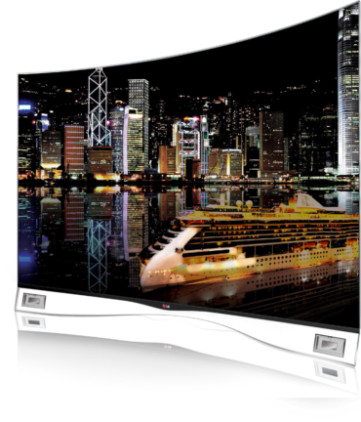
Dubai
South Koreans are leading the race in launching the emerging technology in TV segment – OLED (organic light-emitting diode) – which can produce images sharper than the current liquid-crystal-display (LCD) models.
The OLED TVs are thin and flexibile. The difference between the curved and flat OLED displays is that the distance between the sofa and TV from the centre and the edges of the TVs is the same.
Samsung launched its 55-inch curved OLED TV this month while LG will be launching its 55-inch curved OLED TV during Gitex Shopper which is taking place from October 5-12. LG showcased the 55-inch flat OLED TV at last year’s Gitex Shopper. Industry experts do not expect the new technology to be a “game-changer” due to the high production cost and manufacturing difficulties. The factories for mass production are not available until next year. There will be production, albeit at a slow pace.
“This technology, already used in certain smartphones, uses less power than LCD and has higher contrast rate and creates more vivid images,” Sweta Dash, senior director for display research at HIS, told Gulf News.
She said that OLED TVs will really serve the high end of the market. The cost is very high. The 55-inch curved OLED will cost $9,000 (Dh32,400) and a 50-inch LCD TV will cost only $1,000 in the US. The price difference is around nine times but the quality is in very high definition.
“The concern is that whether consumers will pay nine times more for an OLED TV just for the high picture quality. It will take some time for panel manufacturers to reduce the price of OLED panels and the volumes produced also are not that high,” she said.
Michele Reitz, senior research analyst at semiconductor and electronics division at Gartner, said that manufacturing larger displays above 20 inches are expensive. Mass production will be tough. The adoption curve for OLED TVs will be less than one per cent of the total LCD sales by 2017.
“We are sure that OLED technology will not go in the line of 3D technology and will be adopted very slowly, Reitz said.
Dash believes that cash-rich Mideast countries can afford these technologies but it will be very limited. Globally, around 5,000 OLED TVs are likely to sell this year. In the MEA, only 1,000 units are expected to be sold.
Demand
4K TV or ultra-high definition TV will be more in demand than OLED due to the cost factor. Many low-cost 4K TVs will be produced this year. They boast a pixel format of 3840 x 2160 pixels, four times that of current 1920x1080p Full HD TVs, and have great clarity and depth. But despite the awesome viewing experience, few consumers are likely to want to own one of these ultra-high definition 4K TVs due to its exorbitant cost.
Global ultra-high definition TV shipments are expected to reach 2.3 million units this year and by 2017 it will reach 20.8 million.
Dash said that 4K TVs are gaining acceptance across the world as Taiwanese suppliers are reducing the panel prices and Chinese brands are offering low-priced 4K TVs. We are seeing shift towards 4K TV acceptance this year. Some of the brands have reduced the prices of 4K TVs in the second half.
Sony, Samsung and LG have launched 4K TVs in the market.
“Sony is not launching OLED in the region this year and instead it is focusing on 4K TVs,” a company spokesperson said.
Sony has launched 4K in three different sizes. Sony is selling its 84-inch for Dh99,000, 65-inch for 29,999 and 55-inch for 19,999. LG is selling it 84-inch model for Dh79,999 and Samsung is selling its 85-inch for Dh129,999.
Manu Mahdi, General Manager at Sharp Corporation, said, “We have no plans for OLED TVs in the next six months. But we will launch 4K TVs by Christmas in the sizes of 60 and 70 inches.”
“We will also be launching next-generation LCD technology — indium gallium zinc oxide [IGZO] — by 2014. IGZO is patented by Sharp and achieves a resolution close to OLED TV and can reduce energy consumption by up to 90 per cent,” Mahdi said.
Rumours are that Apple is most likely to use Sharp’s IGZO display technology for its next iPad and MacBook Pro versions.
Dash said that TV manufacturers are expected to ship OLED 4K TV technology by next year. Right now LCD TV has 4K technology, which is ultra-high definition TV.
Manufacturing
Even in 2018, Dash said that LCD 4K will be higher than OLED 4K. LCD panel prices will continue to fall in the years to come compared to OELD TV panels. OLED panel prices will take time to fall due to manufacturing difficulties.
Right now 4K TVs does not have 4K content. The present 2K content produced by the Full HD TV can be upscaled to 4K by the TV software. “4K TV with real 4K content is like watching through the window. The content for 4K is less now but it will grow by next year,” Dash said.
According to Gartner, around 33 per cent of smartphones developed will have OLED technology in 2017 and 17 per cent of the total TVs sold will be 4K ultra HD TV. “We are sure that OLED technology will not go in the line of 3D technology and will be adopted very slowly. Plasma TVs are definitely on the slowdown and by 2017 we expect most of TV manufacturers will exit this technology,” Reitz said.
She said the adoption of this emerging technology will be slow due to its price factor. Only early adopters will purchase OLED TVs. “A new technology that is coming to the LCD sector, known as Quantum dot, will help increase the picture quality as close to OLED TV. Next year we can see some improvements in LCD picture quality,” Dash said.











